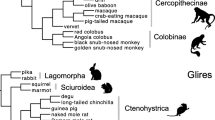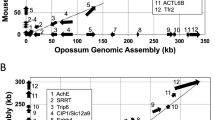Abstract
Proteins involved in reproduction appear to be evolving adaptively across taxa. This rapid evolution is thought to be the result of forces involved in sexual selection. One of the most often suggested of these forces is sexual conflict involving sperm competition and polyspermy avoidance. Bird species offer a unique opportunity to test this hypothesis since the avian egg coat tolerates physiological polyspermy, or the penetration of multiple sperm during fertilization, without negative effects on later development. Despite this, and the extensive amount of data gathered on sexual selection in birds, there are limited studies on the patterns of evolution of avian reproductive proteins. Here we present an analysis of the pattern of evolution of Zona Pellucida 3 (ZP3), a protein present on the avian egg coat. We found that, across several galliform and a single anseriform species, ZP3 appears to be diverging by positive adaptive evolution. In an exploratory analysis of portions of the gene in Callipepla californica we also found evidence of a selective sweep at the putative sperm binding region of the protein. In sum, ZP3 in birds, like reproductive proteins in other species, appears to be adaptively evolving. This result suggests that polyspermy avoidance is not sufficient to explain positive Darwinian selection in reproductive proteins across taxonomic groups. Clearly, the inclusion of bird species in the study of reproductive proteins across taxa promises to add greatly to the discussion of the factors driving the widespread phenomenon of adaptive evolution in reproductive proteins.


Similar content being viewed by others
References
Andersson M (1994) Sexual selection. Princeton University Press, Princeton, NJ
Anisimova M, Bielawski JP, Yang Z (2001) Accuracy and power of the likelihood ratio test in detecting adaptive molecular evolution. Mol Biol Evol 18: 1585–1592
Armstrong MH, Braun EL, Kimball RT (2001) Phylogenetic utility of avian ovomucoid intron G: a comparison of nuclear and mitochondrial phylogenies in galliformes. Auk 118: 799–804
Bausek N, Ruckenbauer HH, Pfeifer S, Schneider WJ, Wohlrab F (2004) Interaction of sperm with purified native chicken ZP1 and ZPC proteins. Biol Reprod 71: 684–690
Bellairs R, Harkness M Harkness RD (1963) The vitelline membrane of the hen’s egg: a chemical and electron microscopical study. J Ultrastruct Res 8: 339–359
Berlin S, Smith NGC (2005) Testing for adaptive evolution of the female reproductive protein ZPC in mammals, birds and fishes reveals problems with the M7-M8 likelihood ratio test. BMC Evol Biol 5: 65
Birkhead TR, Fletcher F (1994) Numbers of spermatozoa attached to and penetrating perivitelline layers of Japanese Quail eggs. Auk 111: 997–1000
Birkhead TR, Fletcher F (1998) Sperm transport in the reproductive tract of female zebra finches (Taeniopygia guttata). J Reprod Fertil 114: 141–145
Birkhead TR, Brillard J-P (2007) Reproductive isolation in birds, postcopulatory, prezygotic barriers. Trends Ecol Evol 22: 266–272
Ceplitis H, Ellegren H (2004) Adaptive molecular evolution of HINTW, a female specific gene in birds. Mol Biol Evol 24: 249–254
Civetta A (2003) Shall we dance or shall we fight? Using DNA sequence data to untangle controversies surrounding sexual selection. Genome 46: 925–929
Clark NL, Aargaard JE, Swanson WJ (2006) Evolution of reproductive proteins from animals and plants. Reproduction 131: 11–22
Crowe TM, Rauri CKB, Bloomer P, Mandiwana TG, Hedderson TAJ, Randi E, Pereira SL, Wakeling J (2006) Phylogenetics, biogeography and classification of, and character evolution in, gamebirds (Aves: Galliformes): effects of character exclusion, data partitioning and missing data. Cladistics 22: 495–532
Darwin C (1871) The descent of man, and selection in relation to sex. Murray, London
Dimcheff DE, Drovetski SV, Mindell DP (2002) Phylogeny of Tetraoninae and other galliform birds using mitochondrial 12S and ND2 genes. Mol Phylogenet Evol 24: 203–215
Dorus S, Evans PD, Wyckoff GJ, Choi SS, Lahn BT (2004) Rate of molecular evolution of the seminal protein gene SEMG2 correlates with levels of female promiscuity. Nat Genet 36: 1326–1329
Dyke GJ, van Tuinen M (2004) The evolutionary radiation of modern birds (Neornithes): reconciling molecules, morphology, and the fossil record. Zool J Linn Soc 141: 153–177
Eberhard W (1996) Female control. Princeton University Press, Princeton, NJ
Ewing B, Green P (1998) Basecalling of automated sequencer traces using phred. II. Error probabilities. Genome Res 8: 186–194
Ewing B, Hillier L, Wendl MC, Green P (1998) Base-calling of automated sequencer traces using phred. I. Accuracy assessment. Genome Res 8: 175–185
Felsenstein J (1981) Evolutionary trees from DNA sequences: a maximum likelihood approach. J Mol Evol 17: 368–376
Frank SA (2000) Sperm competition and female avoidance of polyspermy mediated by sperm-egg biochemistry. Evol Ecol Res 2: 613–625
Fu Y-X, Li W-H (1993) Statistical tests of neutrality of mutations. Genetics 133: 693–709
Gavrilets S (2000) Rapid evolution of reproductive barriers driven by sexual conflict. Nature 403: 886–889
Gavrilets S, Waxman D (2002) Sympatric speciation by sexual conflict. Proc Natl Acad Sci USA 99: 10533–10538
Gordon D, Abajian C, Green P (1998) Consed: a graphical tool for sequence finishing. Genome Res 8: 195–202
Hayashi T, Vose M, Gavrilets S (2007) Genetic differentiation by sexual conflict. Evolution 61: 516–529
Haygood R (2004) Sexual conflict and protein polymorphism. Evolution 58: 1414–1423
Hebert PDN, Stoeckle MY, Zemlak TS, Francis CM (2004) Identification of birds through DNA barcodes. PLoS Biol 2: 1657–1663 (DOI:10.1371/journal.pbio.0020312)
Herlyn H, Zischler H (2007) Sequence evolution of the sperm ligand zonadhesin correlates negatively with body weight dimorphism in primates. Evolution 61: 289–298
Kimball RT, Braun EL, Zwartjes PW, Crowe TM, Ligon JD (1999) A molecular phylogeny of the pheasants and partridges suggests that these lineages are not monophyletic. Mol Phylogenet Evol 11: 38–54
Kingan SB, Tator M, Rand DM (2004) Reduced polymorphism in the chimpanzee semen coagulating protein, semenogelin I. J Mol Evol 57: 159–169
Lee Y-H, Ota T, Vacquier VD (1995) Positive selection is a general phenomenon in the evolution of abalone sperm lysin. Mol Biol Evol 12:231–238
Nickerson DA, Tobe VO, Taylor SL (1997) Polyphred: Automating the detection and genotyping of single nucleotide substitutions using fluorescence based resequencing. Nucleic Acids Res 25: 2745–2751
Okumura H, Kohno Y, Iwata Y, Mori H, Aoiki N, Sato C, Kitajima K, Nadano D, Matsuda T (2004) A newly identified zona pellucida glycoprotein, ZPD, and dimeric ZP1 of chicken egg envelope are involved in sperm-egg interaction. Biochem J 384: 191–199
Palumbi SR (1999) All males are not created equal: Fertility differences depend on gamete recognition polymorphisms in sea urchins. Proc Natl Acad Sci USA 96: 12632–12637
Rambaut A (1996) Se-Al: Sequence alignment editor. Oxford. http://www.evolve.zoo.ox.ac.uk
Rozas J, Rozas R (1999) DnaSP version 3: an integrated program for molecular population genetics and molecular evolution analysis. Bioinformatics 15: 174–175
Rozen S, Skaletsky H (2000) Primer3 on the WWW for general users and for biologist programmers. Methods Mol Biol 132: 365–386
Stephens M, Smith NJ, Donnelly P (2001) A new statistical method for haplotype reconstruction from population data. Am J Hum Genet 68: 978–989
Stewart SG, Bausek N, Wohlrab F, Schneider WJ, Horraks AJ, Wishart GJ (2004) Species specificity in avian sperm: perivitelline interaction. Comp Biochem Physiol A Mol Integr Physiol 137: 657–663
Swanson WJ, Vacquier VD (2002) Reproductive protein evolution. Annu Rev Ecol Syst 33: 161–179
Swanson WJ, Yang Z, Wolfner MF, Aquadro CF (2001) Positive Darwinian selection drives the evolution of several female reproductive proteins in mammals. Proc Natl Acad Sci USA 98: 2509–2514
Swanson WJ, Nielsen R, Yang Z (2003) Pervasive adaptive evolution in mammalian fertilization proteins. Mol Biol Evol 20: 18–20
Takeuchi Y, Nishimura K, Aoki N, Adachi T, Sato C, Kitajima K, Matsuda T (1999) A 42-kDa glycoprotein from chicken egg-envelope, an avian homolog of the ZPC family glycoproteins in mammalian zona pellucida. Eur J Biochem 260: 736–742
Tajima F (1989) Statistical method for testing the neutral mutation hypothesis by DNA polymorphism. Genetics 123: 585–595
Tarin JJ, Cano A (Eds) (2000) Fertilization in protozoa and metazoan animals. Springer, Berlin
Vacquier VD, Swanson WJ, Hellberg ME (1995) What have we learned about sea urchin sperm bindin? Dev Growth Differ 37: 1–10
Wishart GJ (1987) Regulation of the length of the fertile period in the domestic fowl by numbers of oviductal spermatozoa. J Reprod Fertil 80: 493–498
Yang Z, Wong WS, Nielsen R (2005) Bayes empirical bayes inference of amino acid sites under positive selection. Mol Biol Evol 22: 1107–1118
Zink RM, Blackwell RC (1998) Molecular systematics of the Scaled Quail complex (genus Callipepla). Auk 115: 394–403
Acknowledgments
We thank the Swanson lab and five anonymous reviewers for helpful comments on the manuscript. We also thank the Burke Museum’s genetic resource and Dr. Jennifer Gee for access to samples. Blood samples for Callipepla californica were collected under the California Department of Fish and Game permit No. 6942 and the institutional animal care and use committee of the University of California, Irvine (permit no. 95-1664). JDC and WJS are supported by NIH grant HD42563 and NSF DEB-041022.
Author information
Authors and Affiliations
Corresponding author
Electronic supplementary material
Rights and permissions
About this article
Cite this article
Calkins, J.D., El-Hinn, D. & Swanson, W.J. Adaptive Evolution in an Avian Reproductive Protein: ZP3. J Mol Evol 65, 555–563 (2007). https://doi.org/10.1007/s00239-007-9034-8
Received:
Revised:
Accepted:
Published:
Issue Date:
DOI: https://doi.org/10.1007/s00239-007-9034-8




